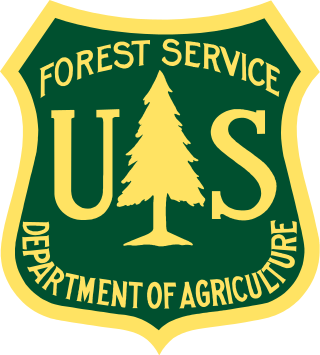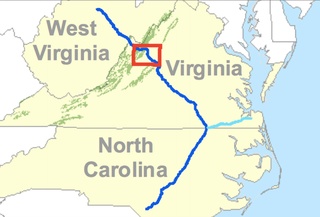
The United States Forest Service (USFS) is an agency within the U.S. Department of Agriculture that administers the nation's 154 national forests and 20 national grasslands covering 193 million acres (780,000 km2) of land. The major divisions of the agency are the Chief's Office, National Forest System, State and Private Forestry, Business Operations, as well as Research and Development. The agency manages about 25% of federal lands and is the sole major national land management agency not part of the U.S. Department of the Interior.

The Federal Energy Regulatory Commission (FERC) is the independent agency of the United States government that regulates the transmission and wholesale sale of electricity and natural gas in interstate commerce and regulates the transportation of oil by pipeline in interstate commerce. FERC also reviews proposals to build interstate natural gas pipelines, natural gas storage projects, and liquefied natural gas (LNG) terminals, in addition to licensing non-federal hydropower projects.

Point Reyes National Seashore is a 71,028-acre (287.44 km2) park preserve located on the Point Reyes Peninsula in Marin County, California. As a national seashore, it is maintained by the US National Park Service as an important nature preserve. Some existing agricultural uses are allowed to continue within the park. Clem Miller, a US Congressman from Marin County, wrote and introduced the bill for the establishment of Point Reyes National Seashore in 1962 to protect the peninsula from development which was proposed at the time for the slopes above Drake's Bay.

The National Environmental Policy Act (NEPA) is a United States environmental law that promotes the enhancement of the environment and established the President's Council on Environmental Quality (CEQ). The law was enacted on January 1, 1970. To date, more than 100 nations around the world have enacted national environmental policies modeled after NEPA.
An environmental impact statement (EIS), under United States environmental law, is a document required by the 1969 National Environmental Policy Act (NEPA) for certain actions "significantly affecting the quality of the human environment". An EIS is a tool for decision making. It describes the positive and negative environmental effects of a proposed action, and it usually also lists one or more alternative actions that may be chosen instead of the action described in the EIS. Several U.S. state governments require that a document similar to an EIS be submitted to the state for certain actions. For example, in California, an Environmental Impact Report (EIR) must be submitted to the state for certain actions, as described in the California Environmental Quality Act (CEQA). One of the primary authors of the act is Lynton K. Caldwell.

Two forms of black-tailed deer or blacktail deer that occupy coastal woodlands in the Pacific Northwest of North America are subspecies of the mule deer. They have sometimes been treated as a species, but virtually all recent authorities maintain they are subspecies.
The Forest and Rangeland Renewable Resources Planning Act of 1974(RPA) (16 U.S.C. §§ 1600 et seq.) is a United States federal law which authorizes long-range planning by the United States Forest Service to protect, develop, and enhance the productivity and other values of forest resources. RPA requires that a renewable resource assessment and a Forest Service plan be prepared every ten and five years, respectively, to plan and prepare for the future of natural resources. RPA was reorganized, expanded, and otherwise amended by the National Forest Management Act of 1976.

The California Wilderness Act of 1984 is a federal law, passed by the United States Congress on September 28, 1984, that authorized the addition of over 3 million acres (12,000 km2) within the state of California to the National Wilderness Preservation System. Conservation activist George Whitmore later credited the Act with establishing "the longest stretch of de facto wilderness in the lower 48 states."
Coeur Alaska, Inc. v. Southeast Alaska Conservation Council, 557 U.S. 261 (2009), is a United States Supreme Court case that was decided in favor of Coeur Alaska's permit to dump mine waste in a lake. The case addressed tailings from the Kensington mine, an underground mine located in Alaska. The gold mine had not operated since 1928, and Coeur Alaska obtained a permit in 2005 from the United States Army Corps of Engineers (USACE) to dispose of up to 4.5 million tons of tailings in Lower Slate Lake, which is located in a National Forest.
Union Hill is an unincorporated community in Buckingham County, Virginia, that was founded by freed slaves after the American Civil War.
Lyng v. Northwest Indian Cemetery Protective Association, 485 U.S. 439 (1988), was a United States Supreme Court landmark case in which the Court ruled on the applicability of the Free Exercise Clause to the practice of religion on Native American sacred lands, specifically in the Chimney Rock area of the Six Rivers National Forest in California. This area, also known as the High Country, was used by the Yurok, Karuk, and Tolowa tribes as a religious site.
Entergy Corp. v. Riverkeeper, Inc., 556 U.S. 208 (2009), is a decision by the United States Supreme Court that reviewed the Environmental Protection Agency's (EPA) interpretation of the Clean Water Act regulations with regard to cooling water intakes for power plants. Existing facilities are mandated to use the "Best Technology Available" to "minimize the adverse environmental impact." The issue was whether the agency may use a cost–benefit analysis (CBA) in choosing the Best Available Technology or (BAT) to meet the National Performance Standards (NPS).
Rosemont Copper is a proposed large open pit copper mine project by the Canadian mining corporation Hudbay Minerals. The project site is located within the Santa Rita Mountains and Coronado National Forest, in Pima County of southern Arizona. It has undergone a permitting review process under the direction of the United States Forest Service and the U.S. Army Corps of Engineers and has been delayed by legal judgements and suspension of its operating permit by the US Army Corps of Engineers.
Marvin Brandt Revocable Trust v. United States, 572 U.S. 93 (2014), was a United States Supreme Court case in which the Court held that a railroad right-of-way granted under the General Railroad Right-of-Way Act of 1875 is an easement. Therefore, when a railroad abandons such a right-of-way, the easement disappears, and the land owner regains unburdened use of the land.
California Coastal Comm'n v. Granite Rock Co., 480 U.S. 572 (1987), is a United States Supreme Court case addressing the question of whether United States Forest Service regulations, federal land use statutes and regulations, or the Coastal Zone Management Act of 1972, preempt the California Coastal Commission's imposition of a permit requirement on operation of an unpatented mining claim in a national forest. The court ruled that even if federal land is not included in the Coastal Zone Management Act's interpretation of "coastal zone," the act does not automatically preempt all state regulation of activities on federal lands.

The Atlantic Coast Pipeline was a planned natural gas pipeline slated to run 600 miles (970 km) from West Virginia, through Virginia, to eastern North Carolina. It was canceled in July 2020.

The Mountain Valley Pipeline (MVP) is a natural gas pipeline being constructed from northwestern West Virginia to southern Virginia. The MVP will be 304 miles (489 km) long, and there is also a proposed Southgate Extension which will run 75 miles (121 km) from Virginia into North Carolina. The completed pipeline will have a capacity of 2 million dekatherms (Dts) of natural gas per day, with a large quantity of that gas being produced from the Marcellus and Utica shale formations.
The Southern Environmental Law Center (SELC) is the largest 501(c)(3) environmental nonprofit organization in the southeastern United States, with more than 100 attorneys and 200 staff members overall working at the local, state, and federal level. Headquartered in Charlottesville, Virginia, SELC has nine offices in six states: Alabama, Georgia, North Carolina, South Carolina, Tennessee and Virginia. The organization also has an office on Capitol Hill.
Equitrans Midstream Corporation, also known as E-Train, is an American energy company engaged in the pipeline transportion of natural gas and natural gas liquids. It is headquartered in Canonsburg, Pennsylvania.









